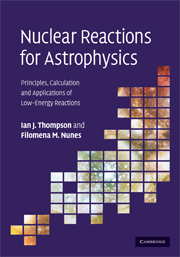Book contents
- Frontmatter
- Contents
- Preface
- Sources of quotations
- Acknowledgements
- 1 Nuclei in the Cosmos
- 2 Reactions of nuclei
- 3 Scattering theory
- 4 Reaction mechanisms
- 5 Connecting structure with reactions
- 6 Solving the equations
- 7 Approximate solutions
- 8 Breakup
- 9 Three-body nuclei
- 10 R-matrix phenomenology
- 11 Compound-nucleus averaging
- 12 Stellar reaction rates and networks
- 13 Connection to experiments
- 14 Spectroscopy
- 15 Fitting data
- Appendix A Symbols
- Appendix B Getting started with Fresco
- Select bibliography
- Index
4 - Reaction mechanisms
Published online by Cambridge University Press: 05 March 2012
- Frontmatter
- Contents
- Preface
- Sources of quotations
- Acknowledgements
- 1 Nuclei in the Cosmos
- 2 Reactions of nuclei
- 3 Scattering theory
- 4 Reaction mechanisms
- 5 Connecting structure with reactions
- 6 Solving the equations
- 7 Approximate solutions
- 8 Breakup
- 9 Three-body nuclei
- 10 R-matrix phenomenology
- 11 Compound-nucleus averaging
- 12 Stellar reaction rates and networks
- 13 Connection to experiments
- 14 Spectroscopy
- 15 Fitting data
- Appendix A Symbols
- Appendix B Getting started with Fresco
- Select bibliography
- Index
Summary
An expert is a man who has made all the mistakes which can be made in a very narrow field.
Niels BohrThis chapter shows how the interactions in and between channels may be calculated on the basis of some potential model for a few interacting bodies. That is, a Hamiltonian is defined whose matrix elements give rise to channel couplings, also known as transition potentials. The parameters in this Hamiltonian may be found either from structure models (Chapter 5), or from fitting data (Chapter 15). It is also possible to directly fit to experiment the effects of these couplings on the asymptotic amplitudes of the wave functions, and this is the basis of the R-matrix phenomenology discussed in Chapter 10.
Optical potentials
Beforewecan discuss more detailed reaction mechanisms,weneed to see the typical kinds of potentials used for elastic scattering, and also the binding potentials needed to reproduce the usual single-particle structures of nucleons within a nucleus. We will start by describing the most commonly used optical potentials for elastic scattering, expanding on the introduction in Box 3.4.
Typical forms
The interaction potential between a nucleon and a spherical nucleus is usually described by an attractive nuclear well of depth Vr with a radius Rr slightly larger than the nuclear matter radius, and a diffuse nuclear surface.
- Type
- Chapter
- Information
- Nuclear Reactions for AstrophysicsPrinciples, Calculation and Applications of Low-Energy Reactions, pp. 129 - 172Publisher: Cambridge University PressPrint publication year: 2009



